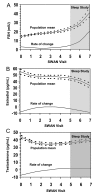Sex steroid hormone profiles are related to sleep measures from polysomnography and the Pittsburgh Sleep Quality Index
- PMID: 18853931
- PMCID: PMC2572739
Sex steroid hormone profiles are related to sleep measures from polysomnography and the Pittsburgh Sleep Quality Index
Abstract
Study objectives: To relate reproductive hormones (and the preceding 7-year rates of their change) to objectively and subjectively assessed sleep measures, independent of age, vasomotor symptom frequency, depressive symptoms, and body size.
Design: A cross-sectional sleep substudy nested in the Study of Women's Health Across the Nation (SWAN), a longitudinal study of the menopausal transition.
Setting: Community-based.
Participants: 365 Caucasian, African American, and Chinese women.
Measurements and results: Sleep duration, continuity, and architecture were measured during two nights of in-home polysomnography (PSG) studies. Participants completed the Pittsburgh Sleep Quality Index (PSQI) for sleep quality, sleep diaries for medication, vasomotor symptoms, lifestyle information and questionnaires for depressive symptoms. Blood collected annually in the years prior to sleep study was assayed for follicle stimulating hormone (FSH), estradiol (E2), and total testosterone (T). More rapid rate of FSH change was significantly associated with higher delta sleep percent, longer total sleep time (TST), but less favorable self-reported sleep quality (PSQI). Baseline E2 was modestly and negatively associated with sleep quality. Women in the lowest total testosterone quartile at baseline had more wake time after sleep onset (WASO) than women in the highest quartile. Lower E2/T ratio, an index reflecting the increasing androgenic environment with the menopause transition, was associated with less WASO.
Conclusions: More rapid rate of FSH change was associated with longer sleep duration but poor sleep quality. Women with higher T or who were closer to the completion of the transition process (as indexed by a lower E2/T) had less sleep discontinuity (less WASO).
Figures






Similar articles
-
The relationship of longitudinal change in reproductive hormones and vasomotor symptoms during the menopausal transition.J Clin Endocrinol Metab. 2005 Nov;90(11):6106-12. doi: 10.1210/jc.2005-1374. Epub 2005 Sep 6. J Clin Endocrinol Metab. 2005. PMID: 16144949
-
The association of endogenous hormone concentrations and bone mineral density measures in pre- and perimenopausal women of four ethnic groups: SWAN.Osteoporos Int. 2003 Jan;14(1):44-52. doi: 10.1007/s00198-002-1307-x. Osteoporos Int. 2003. PMID: 12577184
-
Sleep disturbance during the menopausal transition in a multi-ethnic community sample of women.Sleep. 2008 Jul;31(7):979-90. Sleep. 2008. PMID: 18652093 Free PMC article.
-
The menopausal transition--endocrinology.J Sex Med. 2008 Oct;5(10):2266-73. doi: 10.1111/j.1743-6109.2008.00921.x. Epub 2008 Jul 1. J Sex Med. 2008. PMID: 18624962 Review.
-
Sleep and Sleep Disorders in the Menopausal Transition.Sleep Med Clin. 2018 Sep;13(3):443-456. doi: 10.1016/j.jsmc.2018.04.011. Sleep Med Clin. 2018. PMID: 30098758 Free PMC article. Review.
Cited by
-
Nocturnal Hot Flashes, but Not Serum Hormone Concentrations, as a Predictor of Insomnia in Menopausal Women: Results from the Midlife Women's Health Study.J Womens Health (Larchmt). 2023 Jan;32(1):94-101. doi: 10.1089/jwh.2021.0502. Epub 2022 Nov 25. J Womens Health (Larchmt). 2023. PMID: 36450126 Free PMC article.
-
Disruption of Sleep Continuity During the Perimenopause: Associations with Female Reproductive Hormone Profiles.J Clin Endocrinol Metab. 2022 Sep 28;107(10):e4144-e4153. doi: 10.1210/clinem/dgac447. J Clin Endocrinol Metab. 2022. PMID: 35878624 Free PMC article.
-
Impact of sleep patterns upon female neuroendocrinology and reproductive outcomes: a comprehensive review.Reprod Biol Endocrinol. 2022 Jan 18;20(1):16. doi: 10.1186/s12958-022-00889-3. Reprod Biol Endocrinol. 2022. PMID: 35042515 Free PMC article. Review.
-
Sleep Characteristics and Carotid Atherosclerosis Among Midlife Women.Sleep. 2017 Feb 1;40(2):zsw052. doi: 10.1093/sleep/zsw052. Sleep. 2017. PMID: 28364498 Free PMC article.
-
Sleep disorders impact hormonal regulation: unravelling the relationship among sleep disorders, hormones and metabolic diseases.Diabetol Metab Syndr. 2025 Aug 1;17(1):305. doi: 10.1186/s13098-025-01871-w. Diabetol Metab Syndr. 2025. PMID: 40750881 Free PMC article. Review.
References
-
- Manber R, Armitage R. Sex, steroids, and sleep: a review. Sleep. 1999;22:540–55. - PubMed
-
- Ballinger CB. Subjective sleep disturbance at the menopause. J Psychosom Res. 1976;20:509–13. - PubMed
-
- Lee KA, Taylor DL. Is there a generic midlife woman? The health and symptom experience of employed midlife women. Menopause. 1996;3:154–64. Editorial.
-
- Kravitz HM, Ganz PA, Bromberger J, Powell LH, Sutton-Tyrrell K, Meyer PM. Sleep difficulty in women at midlife: a community survey of sleep and the menopausal transition. Menopause. 2003;10:19–28. - PubMed
-
- Shaver JL, Zenk SN. Sleep disturbance in menopause. J Womens Health Gend Based Med. 2000;9:109–18. - PubMed
Publication types
MeSH terms
Substances
Grants and funding
- UL1 TR000005/TR/NCATS NIH HHS/United States
- AG017719/AG/NIA NIH HHS/United States
- AG012553/AG/NIA NIH HHS/United States
- UL1 RR024153/RR/NCRR NIH HHS/United States
- AG019363/AG/NIA NIH HHS/United States
- NR004061/NR/NINR NIH HHS/United States
- U01 AG012554/AG/NIA NIH HHS/United States
- R01 AG019361/AG/NIA NIH HHS/United States
- AG012554/AG/NIA NIH HHS/United States
- AG019362/AG/NIA NIH HHS/United States
- R01 AG019362/AG/NIA NIH HHS/United States
- AG012539/AG/NIA NIH HHS/United States
- AG17104/AG/NIA NIH HHS/United States
- AG012531/AG/NIA NIH HHS/United States
- U01 AG012535/AG/NIA NIH HHS/United States
- U01 AG012553/AG/NIA NIH HHS/United States
- U01 NR004061/NR/NINR NIH HHS/United States
- U01 AG012539/AG/NIA NIH HHS/United States
- AG012495/AG/NIA NIH HHS/United States
- AG019361/AG/NIA NIH HHS/United States
- U01 AG012546/AG/NIA NIH HHS/United States
- U01 AG012495/AG/NIA NIH HHS/United States
- U01 AG012505/AG/NIA NIH HHS/United States
- R01 AG017104/AG/NIA NIH HHS/United States
- U01 AG012531/AG/NIA NIH HHS/United States
- R01 AG019363/AG/NIA NIH HHS/United States
- U01 AG017719/AG/NIA NIH HHS/United States
- AG012505/AG/NIA NIH HHS/United States
- RR024153/RR/NCRR NIH HHS/United States
- AG012535/AG/NIA NIH HHS/United States
- AG012546/AG/NIA NIH HHS/United States
- AG019360/AG/NIA NIH HHS/United States
- R01 AG019360/AG/NIA NIH HHS/United States
LinkOut - more resources
Full Text Sources
